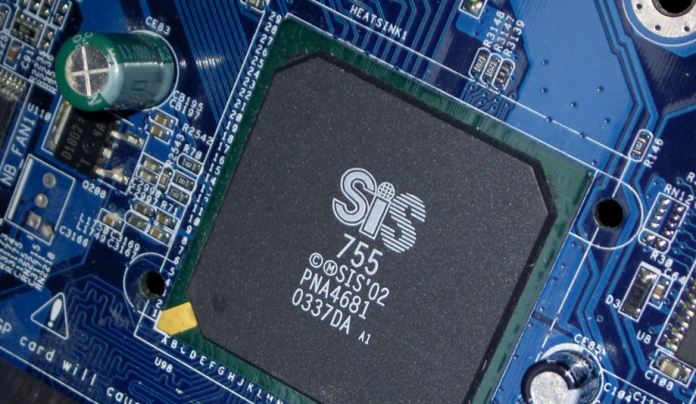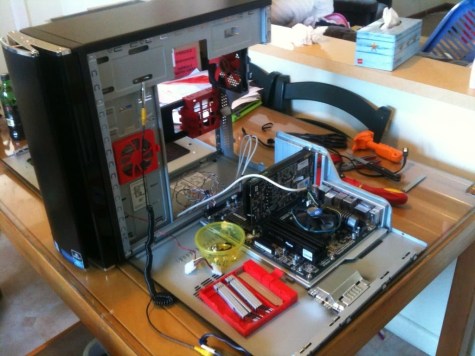
Symptoms: vertical or horizontal lines on the screen, black screen, restart loop, GPU Chip overheating or computer not starting at all.
Alright, let’s dive into the nitty-gritty of hardware tales, where the motherboard takes center stage like the grand conductor in a symphony orchestra, linking all those hardware components together. But hey, that also means it’s prone to drama, especially when other hardware bits start misbehaving.
So, inside that motherboard mansion, there are two VIP chips: the North Bridge Chipset and the South Bridge Chipset. These chips are like the communication superheroes, ensuring everyone in the hardware neighborhood gets along smoothly with the CPU. The north bridge, in particular, handles the high-speed stuff like RAM and flashy displays, even moonlighting as an integrated graphics card when there’s no external one connected.
Now, imagine this scenario: your desktop monitor starts doing the rainbow dance or throws a pixel party when it shouldn’t. That could be a cue that the North Bridge chip might be feeling under the weather, causing the whole show to go a bit haywire.

As well as, a misbehaving North Bridge chip might give your monitor the silent treatment, flashing messages like ‘No Display Screen’ or begging you to check the signal cable. And that’s not all the drama it can bring—sudden shutdowns, endless restart loops, and even a visit from the dreaded Blue Screen of Death (BSOD) could crash the party due to this troublesome chip.
This chip might seem like a small fry, but it wields immense power over your computer’s performance after the CPU takes its bow. So, besides a chip replacement, you’ve got two potential fixes: reflowing or reballing. It’s like giving your computer a mini-spa day to get back into its top-notch groove.
- Fixing Laptop’s Display Problem by Reflowing its GPU (Graphics Chip)
- How to Repair a Graphics Card by Reflow?
So, let’s see how Reflow can help
Extreme computer usage or exposing your tech gear to humid places can trigger some really nasty stuff. We’re talking about corrosion or disruptions within the north bridge chip connections, causing serious hiccups in your motherboard’s communication game.

Now, when it comes to fixing these glitches, reflow soldering steals the show. Service centers and repair shops swear by this technique. Basically, it’s all about heating up that solder till it goes from solid to liquid at crazy high temps, reconnecting those electronic bits and bobs on the motherboard’s PCB. That’s the secret sauce to get your north bridge chip flexing its connection muscles again, ensuring top-notch performance.
But wait! If your computer shows nothing on the screen, don’t rush to mess with the motherboard. Check out my guide on “How to Fix “No Display” or “No Signal” Desktop Computer’s Problem?“ or “How to Fix Black Blank or No Display Laptop’s Problem?“ first. Sometimes, the screen blankness isn’t because of the motherboard acting up. It could be tiny problems in the computer’s other parts causing the issue.
So Let’s See How To Reflow The Desktop Motherboard;
In this comprehensive guide, my goal is to provide you with a detailed step-by-step process for conducting a reflow procedure utilizing common household items.
- Motherboard Disassembly: First things first, take the motherboard out of your computer’s case to kickstart the reflow process. But here’s the kicker: make sure your motherboard isn’t under warranty because trying to reflow might void that warranty. If it’s covered, it’s safer to let the manufacturer’s authorized service center handle it.

- Find the Chip: Next up, spot that Northbridge or integrated GPU chip. It’s usually the biggest one, close to the CPU socket. If your motherboard has just one prominent chip, that’s likely the combined north and south bridge (known as the chipset chip). In that case, target this combined chip during the reflow to get things back to normal.

- Shield the Motherboard: Protect the motherboard by covering it up with a metal sheet or foil paper, leaving only the GPU chip exposed. This move shields other parts from accidental heat damage while focusing heat on the GPU chip.

- Get the Heat Ready: Fire up the Heat Gun and set it to around 385°F (195°C) with a regular air pressure setting.
- Heat the GPU: Lower the airspeed and gently heat the GPU chip for roughly 2 to 3 minutes, keeping the temperature between 190-200°C max. Keep the heat gun moving slightly; don’t camp out in one spot too long, or you might cause trouble. Remember, high air pressure can blow away small soldered bits, so keep the pressure low while cranking up the heat.

- Cool Down: Let the motherboard chill out for a good while after the heating session.

- Test Run: Put your computer back together, reconnect everything, and fire it up to see if the reflow did the trick.

If the motherboard still acts up, you might need to redo the process. This time, focus on extending the heating duration (maybe 3 to 4 minutes) instead of playing with the air pressure.
If all else fails, the next step would be reballing;
Remember, these reflow and reballing maneuvers need careful handling and might not guarantee success. Consider seeking pro help or exploring other fixes if this method falls short.
Need a heat gun or screwdriver kit?
Heat Gun With Air Control Starts From: @Amazon US ($28.99), @Amazon UK (£25.99), @Amazon IND (₹799.00), @Walmart US ($29.99), @Newegg ($35.99).
Screwdriver Kit Starts From: @Amazon US ($9.99), @Amazon UK (£9.99), @Amazon IND (₹149.00), @Walmart US ($9.99), @Newegg ($10.99).
Suggested Articles:
- What To Do, When Your Computer Date And Time Keeps Changing?
- Fix For – Screen Flickers When Playing Games
- Fix For – “Start Windows Normally” Not Working With Restarts Loop Problem
- How To Fix A Dead Computer Which Won’t Turn ON?
- How To Fix “Startup Repair Cannot Repair This Computer Automatically” Problem?
- 4 Different Ways to Find Your Motherboard’s Model Number
- Motherboard Cleaning – One Solution to Fix Board Related Problems















Well, the motherboard GPU chip is only in use if the display cable is plugged into the motherboard. Simpler solution, plug the cable into the graphics card
@200 Celcius you just change the surface structure of the GPU chip not the reflow. It needs 400-450 Celcius heat to melt the solder and re atach.
400-450 Celcius is way too much for a reflow, We only need that much of heat when we’re removing the chip from the motherboard to replace it.
If 200 degrees Celcius doesn’t work you then you can again try with the highest 250 degrees and that will work for you.
To know more: https://www.deskdecode.com/reflow/